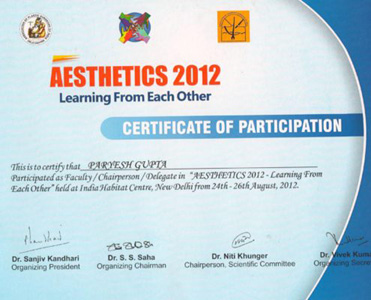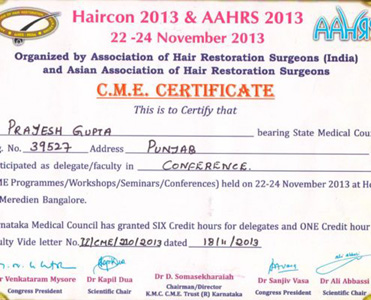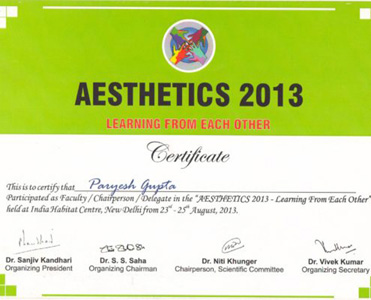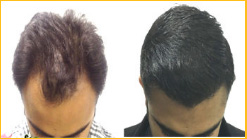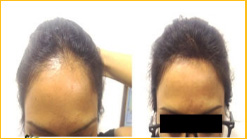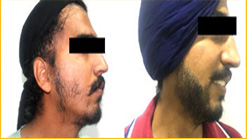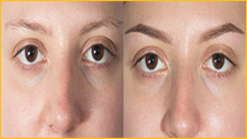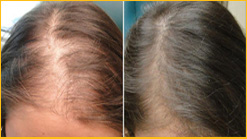Q1.) HOW DOES HAIR TRANSPLANTATION WORK?
Ans. Hair transplantation is really about relocating (transplanting) the bald resistant hair follicles from the back of the head or other body areas to the balding areas on the top of the head. This process works for a lifetime because the hair follicles taken from the back of the head are genetically resistant to baldness(Permanent Hair Zone), regardless of where they are relocated to.
Q2.) DO HAIRS LOOK COMPLETELY NATURAL?
Ans. Hair transplantation, when done right, can be very natural and will not be distinguishable from other areas having natural growth. You can comb, shampoo, cut or colour your transplanted hair.
Q3.) HOW MUCH TIME IS REQUIRED FOR HAIR TRANSPLANT PROCEDURE?
Ans. In general a session of between 2000 to 3,000 grafts involves a full day of surgery( about 6-7 hours) on an out patient basis. (Overnight stay not required)
Q4.) IS THE HAIR TRANSPLANT PROCEDURE PAINFUL?
Ans. Patients are given local anesthesia in the donor and recipient areas. Only minimal pain at the time of injection (for a few minutes)is present.
Q5.) HOW MANY GRAFTS/HAIRS WILL BE REQUIRED?
Ans. The amount of grafts you will need ultimately depends on your degree of baldness ,the density(no. of grafts /cm2 of area)and availability at your donor site.
Q6.) WHAT IS THE RECOVERY/HEALING TIME?
Ans. With today’s very refined micro hair transplantation procedure the incisions are very small and less invasive than past procedures. We use titanium micropunches of size 0.8, 0.9mm (import from USA). This results in more rapid healing. Most patients feel fine within a day or two following surgery, although some numbness and mild soreness can be expected for few days following surgery.
Q7.) WILL PEOPLE KNOW I HAD A HAIR TRANSPLANT?
Ans. Immediately following surgery a patient’s recipient area is typically pink with scabs forming around the micro incisions. These hundreds of tiny incisions will heal rapidly within a week. During the first few days after the surgery a person’s hair transplants will be noticeable if there is no previous hair to mask these temporary scabs. However, most patients feel comfortable being in public without wearing a hat within 5 to 7 days following surgery.Once the transplanted hair grows out the results should look entirely natural, even under close examination.
Q8.) WHEN WILL MY NEWLY TRANSPLANTED HAIR START TO GROW?
Ans. Normally it takes between 7 – 8 months following surgery before the transplanted hair follicles begin to grow new hair. The transplanted hair grows is thin initially and gradually grows thicker and fuller over time. After one year a patient’s transplanted hair will be fully mature and will continue to grow for a life time.
Q9.) ARE THE RESULTS PERMANENT?
Ans. Since the hair follicles that are transplanted to the balding areas are genetically resistant to going bald, they will continue to grow for a life time – just as if they had been left in the bald resistant donor area.
Q10.) HOW DO I FIND AN EXCELLENT HAIR RESTORATION SURGEON?
Ans. The most important decision in restoring your hair is the physician you choose. The skill, talent, and experience of hair restoration physicians vary widely, as do the end results. Who you choose will determine how natural and full your new hair will be for the rest of your life.
Q11.) WHAT IS A HAIR TRANSPLANT EXACTLY?
Ans. Hair transplantation is an artistic redistribution system that takes donor dominant hair follicles donor areas such as from back of the head,beard area ,chest area etc and artfully transplants them into thinning or balding areas. With current microsurgical technologies, this results in a very natural appearance. Basically we take hair from where you have more than you need and put it where you need it more.
Q12.) WHEN CAN I GO BACK TO WORK?
Ans. It is often possible to go back to work in two to five days time. Your hair restoration surgeon will discuss this with you during the consultation.
Q13.) WHAT IS “FOLLICULAR UNIT EXTRACTION”?
Ans. Hair transplantation beginning with traditional larger plugs and culminating in the move to 1, 2, 3, and 4 hair follicular unit hair grafts, which mirror the way hair, grows in nature. Using this advanced technique a surgeon can move more hair in a totally natural way.
Q14.) WHAT ARE THE COMPLICATIONS OR RISKS WITH THE HAIR TRANSPLANT SURGERY?
Ans. Occurrences of infection after the procedure are rare, mainly due to the patient’s failure to fully follow post-operative instructions. Infection is easily treatable with antibiotics, which can be prescribed by the physician.
Q15.) WHAT IS THE TIME GAP BETWEEN INDIVIDUAL SITTINGS?
Ans. Individual sittings of FUE can be planned according to the time available. They can be done even on consecutive days or few days or a week apart whereas in the strip method you have to wait for 6-12 months.
Q16.) WHAT IS THE DIFFERENCE IN THE POST-OP PRECAUTIONS OF BOTH TECHNIQUES?
Ans. In STRIP method, sutures are put at the back of head, so special precautions like sleeping in a particular position, refraining from exercise, avoiding strenuous work etc. are required till the stitches are out. In FUE, the patient walks out of the clinic ,rests for a while and is free to follow daily routine from next day. Even the bandage at the back of head is out the next day. As there are no sutures there is minimal pain post operatively.
Q17.) DO YOU DO HAIR TRANSPLANTATION ON WOMEN?
Ans. Yes. Female hair loss is quite common. “The great majority of women with typical female pattern hair loss can be helped significantly; Women usually have a similar donor area to men. This means they have enough supply to fulfill the demand, so the results are usually very good”.

